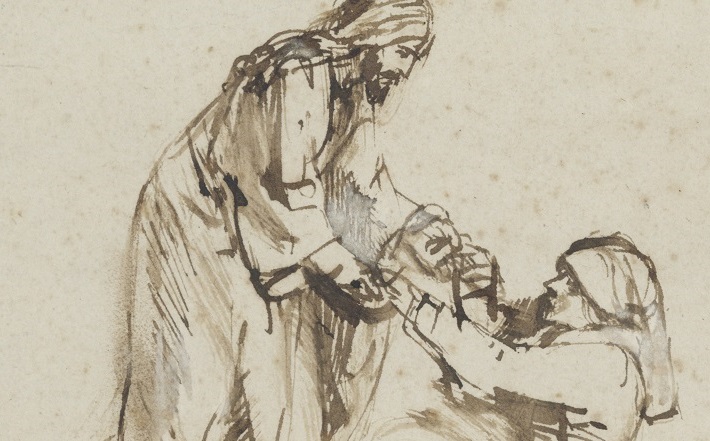In Mark 1:29-35, the gospel scene moves from the public space of the synagogue into the intimacy of a dwelling. The voice that expelled the spirit in the assembly enters the silence of a home. A woman lies in fever, unable to serve, her strength consumed by fire. The fever is more than a medical state, rather a sign of disordered flame, energy without form. Christ approaches, takes her hand, and lifts her up. The gesture carries a depth that words cannot exhaust. The verb used in the text to describe the rising is the same that will later name the resurrection. To be touched by His hand is to be called out of death into service. The fire of fever gives way to the fire of offering. At once she stands and ministers to them. Healing is presented as restoration of function, return to vocation, reinstatement of the body as vessel of service. This passage opens a movement that will transverse house, city, and desert. Each stage speaks of a path within the soul, from intimacy to multitude, from multitude to solitude. The rhythm is simple and exact; touch, crowd, silence. In this, one’s life finds its model.
I. The Hand That Lifts
The hand of Christ enters the place where words have no reach. He does not pronounce a formula, He does not declare victory, He touches and raises. The fever falls. In this act there is no division between body and Spirit. What is raised is the whole being. The woman, restored, begins to serve. Service is the natural fruit of true healing. The fire that once consumed without measure is transfigured into flame of ministry. This is the logic of sacrament: what burns within must become Light for others. The sickness prevented offering; the lifting restored it. In this scene there is already the shadow of the resurrection. The verb of rising is a seed that will later blossom in the tomb. The disciple who witnesses the lifting of a hand in a small house is being prepared for the greater rising that will seal the mystery of salvation. The house becomes a sanctuary; the bed of sickness becomes an altar; the hand becomes a sign of the Spirit. All is transfigured by the simple action of lifting.

II. The City at the Door
As the sun sets, the people gather. The end of the sabbath marks the release of constraint. With twilight comes the flow of bodies toward the one who heals. The entire city presses upon the door. And this door is the image of the liminal space, the point of passage. Those once hidden, unclean, or silenced now stand at the edge, seeking entry. The house becomes the axis where the suffering of the world converges. Christ heals many and expels the spirits. Yet He does not allow the spirits to speak. They know Him, but their voice is forbidden. Knowledge without reverence is profanation; truth spoken by what is impure becomes a weapon against itself. Silence is imposed until the hour is ripe. The mystery of identity is guarded, veiled, sustained in secrecy. The multitude encounters power, but the secret remains hidden. The city at the door is the collective restless soul, longing for Light, pressing at the border yet not fully within. Healing is given, liberation is enacted, but the silence of Christ teaches that revelation requires timing. The veil is not torn before the cross. Until then, the Word walks guarded.
III. The Prayer Before Dawn
While the city still stirs in the memory of cures and exorcisms, Christ withdraws. He rises long before the light, while the darkness covers the earth. He departs to a deserted place and prays. This moment reveals the hidden source of all the gestures. The desert is the place of stripping, where nothing remains except the bond with the Father. One learns in this that every work of service must return to silence. Without the desert, the hand that lifts grows heavy; without the prayer in solitude, the city at the door consumes the soul. The desert is the inner sanctuary where strength is renewed. The rhythm of this passage is complete only with this final step. House, crowd, desert. Service, multitude, silence. The movement describes the path of sanctity. The house is intimacy, the crowd is mission, the desert is union. To pray in the darkness before dawn is to seal the work of the day in the womb of eternity. It is to allow the night itself to carry the burden of the world into the heart of God.
Fiat Lux.
